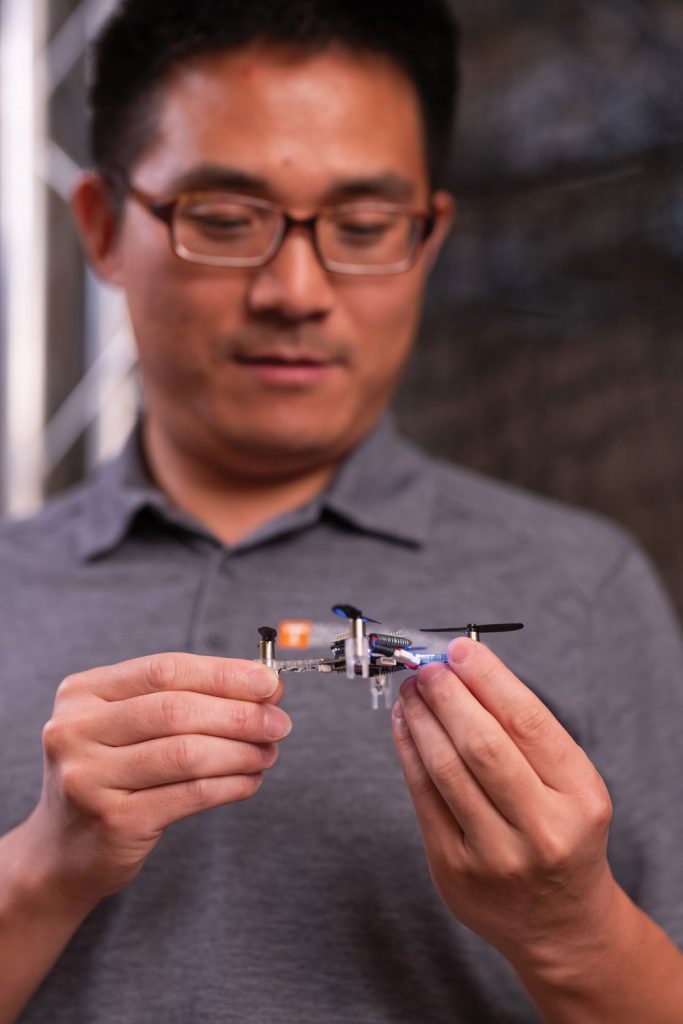
Wang Earns CAREER Award to Help Lay Groundwork for Future of Air Travel.
By Amy Blakely. Photography by Steven Bridges.
Air taxis that can soar over traffic snarls. Small aircraft that allow businesspeople to commute from building top to building top within a city or in nearby cities. Drones that speed package delivery and provide medical and disaster response.
Through its Advanced Air Mobility Mission, NASA is spearheading research that could turn these and other futuristic air transportation dreams into reality. And UT is on board.
Assistant Professor Zhenbo Wang, who runs the Autonomous Systems Laboratory in the Department of Mechanical, Aerospace, and Biomedical Engineering, recently received a Faculty Early Career Development (CAREER) Program award from the National Science Foundation that will provide $537,847 over five years for research toward developing and testing a novel airway system, operational rules, and control schemes for autonomous aircraft of the future.
Most of today’s aircraft depend on ground control to help direct their operation. Autonomous aircraft would require little or no ground control. Eventually some of those aircraft, especially those flying cargo, could be completely flown by computer, without pilots.
These contributions are significant because they are a fundamental step toward reimagining transportation systems by uncovering how high tempo, high-density air mobility operations can be safely and efficiently coordinated in limited airspace.”
Small passenger aircraft, perhaps with only five to nine seats, could fly at lower altitudes than large passenger jets. With ranges of 20 to 300 miles, they could provide quick commutes within cities, between cities and nearby rural areas, or between metropolitan areas that are relatively close. Similar small planes, along with drones, could transport cargo.
Wang’s project has three objectives: to investigate the best physical and digital infrastructures needed for autonomous air mobility systems, to develop flight control and management techniques to better coordinate autonomous vehicles when they are flying, and to conduct simulated and emulated experiments to make sure the systems work.
Wang’s group will collect and optimize data from sensors in the aircraft and the environment to help develop the flight computers that navigate the aircraft. They will devise algorithms to facilitate autonomous control, real-time optimization, and optimal decision-making. They will perform computer simulations to make sure the algorithms work and use drones in the lab’s new 1,000-square-foot netted area to see how the systems work in real life.
“These contributions are significant because they are a fundamental step toward reimagining transportation systems by uncovering how high tempo, high-density air mobility operations can be safely and efficiently coordinated in limited airspace,” Wang said, adding that autonomous air mobility advances will impact multiple fields including transportation, aerospace, smart cities, and civil engineering.
How soon might autonomous air mobility systems be operational?
“Different people have different opinions,” Wang said, adding that some vehicles may be operating in five to 10 years as research continues. He believes a more complex autonomous air mobility system is 20 to 30 years away.
As required by the CAREER award program, Wang’s project includes components that support undergraduate or precollege education and public education about the work.
Wang on NASA Team Studying How Electric Grid Will Support Future Air Travel
Zhenbo Wang, an assistant professor of mechanical, aerospace, and biomedical engineering, is part of a NASA University Leadership Initiative team looking at how the electric grid infrastructure can support future air transportation, including aircraft charging stations, and the predicted charging demand.
ULI is a competitive grant program that allows the academic community to support NASA’s aeronautical research goals and provides students with a chance to learn by working on real world technical challenges.

Wang is part of the team led by Liang Sun, an associate professor of mechanical and aerospace engineering at New Mexico State University. The team has received $6 million to study this aspect of advanced air mobility, or AAM—a field that includes a variety of current and projected transportation systems, such as small piloted or self flying aircraft and drones, to meet the need for air transportation that is safe, efficient, flexible, and environmentally sustainable.
In addition to NMSU and UT Knoxville, the group includes researchers from George Washington University, UT Chattanooga, the University of Maryland in Baltimore County, Aurora Flight Sciences, Argonne National Laboratory, and Whisper Aero, a start-up based in Crossville, Tennessee.
“We share the same interests with different expertise,” he said. “My group focuses on the infrastructure design as well as AAM portal siting with electric grid integration.”
AAM’s physical infrastructure includes facilities such as vertiports—vertical airports that might be located on building rooftops for urban air mobility—or using underutilized existing airports for regional air mobility. Digital infrastructure includes both the airways or air corridors that connect these portals to provide AAM services and the flight management techniques that coordinate aircraft operations.
Since many AAM aircraft are expected to be electric, the team will conduct energy consumption modeling using realworld data; work on developing safe, energy-efficient, and emission-aware operational strategies to meet flight demand; and assess energy costs and emission impacts from an electric grid perspective.
Wang said he expects to focus heavily on how AAM can be used in Tennessee. He will work closely with Whisper Aero, which is already developing a prototype of an AAM passenger aircraft.
